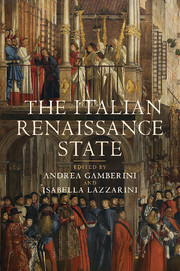Book contents
- Frontmatter
- Contents
- Notes on the contributors
- Note on translations and usage
- Map
- Introduction
- Part I The Italian states
- 1 The kingdom of Sicily
- 2 The kingdom of Naples
- 3 The kingdom of Sardinia and Corsica
- 4 The papal state
- 5 Tuscan states: Florence and Siena
- 6 Ferrara and Mantua
- 7 Venice and the Terraferma
- 8 Lombardy under the Visconti and the Sforza
- 9 The feudal principalities: the west (Monferrato, Saluzzo, Savoy and Savoy-Acaia)
- 10 The feudal principalities: the east (Trent, Bressanone/Brixen, Aquileia, Tyrol and Gorizia)
- 11 Genoa
- Part II Themes and perspectives
- Bibliography
- Index
5 - Tuscan states: Florence and Siena
Published online by Cambridge University Press: 05 August 2012
- Frontmatter
- Contents
- Notes on the contributors
- Note on translations and usage
- Map
- Introduction
- Part I The Italian states
- 1 The kingdom of Sicily
- 2 The kingdom of Naples
- 3 The kingdom of Sardinia and Corsica
- 4 The papal state
- 5 Tuscan states: Florence and Siena
- 6 Ferrara and Mantua
- 7 Venice and the Terraferma
- 8 Lombardy under the Visconti and the Sforza
- 9 The feudal principalities: the west (Monferrato, Saluzzo, Savoy and Savoy-Acaia)
- 10 The feudal principalities: the east (Trent, Bressanone/Brixen, Aquileia, Tyrol and Gorizia)
- 11 Genoa
- Part II Themes and perspectives
- Bibliography
- Index
Summary
Introduction
Research into new ways of interpreting late medieval political change has modified the attitude of historians towards Tuscany: traditional topics such as ‘Renaissance Florence’ have been overtaken by an approach ‘beyond Florence’, aiming to focus on different models of state-building. This new perspective allows historians to analyse the Florentine model in closer comparison with the experiences of the surrounding city-states, the Tuscan republics of Siena and Lucca.
Following these new approaches, I shall focus on the social and institutional evolution of Florence and Siena at the end of the Middle Ages, comparing them to Lucca in the final part of the chapter: the purpose will be to identify some features of the Tuscan political systems and to underline their contribution to the development of the Italian Renaissance state.
Florence: from commune to respublica
Robert Davidsohn took his fundamental Geschichte von Florenz up to 1328: even if his decision was partially due to the difficulty of extending such comprehensive research to the far too richly documented fourteenth century, Davidsohn’s choice provides a useful starting point. The emperor’s absence from the Italian political scene and the displacement of the papal court to Avignon in fact gave the most important city-states in central Italy new chances to fulfil their ambitions.
- Type
- Chapter
- Information
- The Italian Renaissance State , pp. 90 - 111Publisher: Cambridge University PressPrint publication year: 2012
- 2
- Cited by

